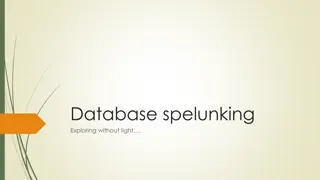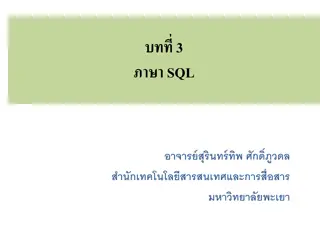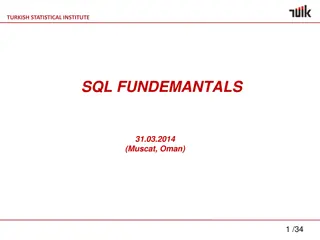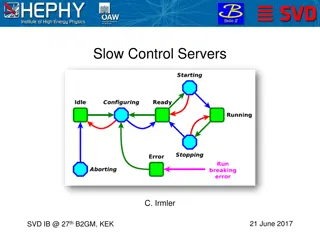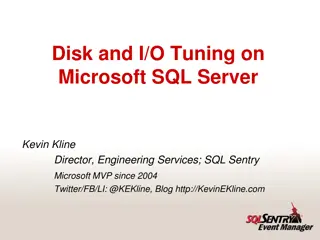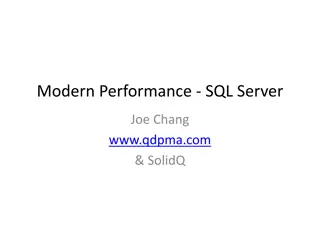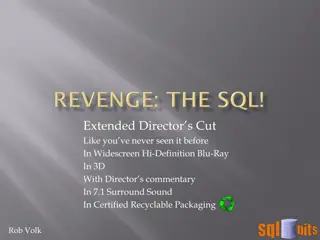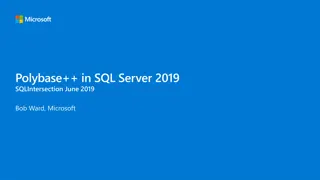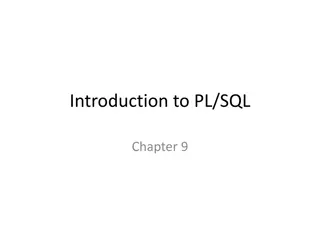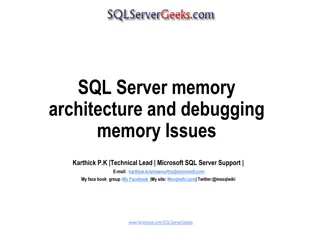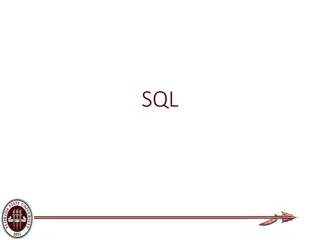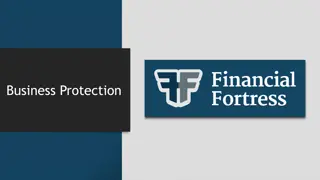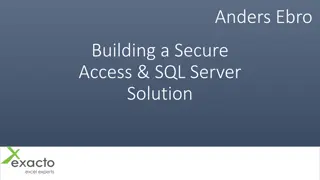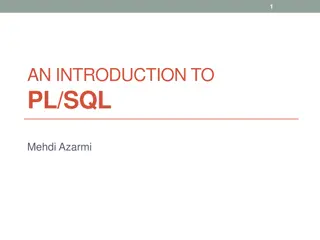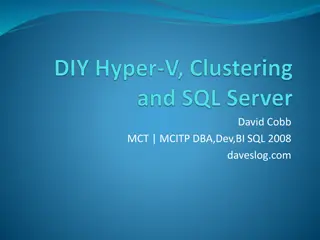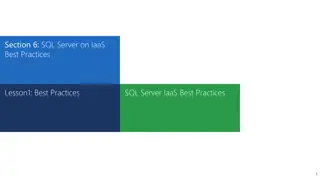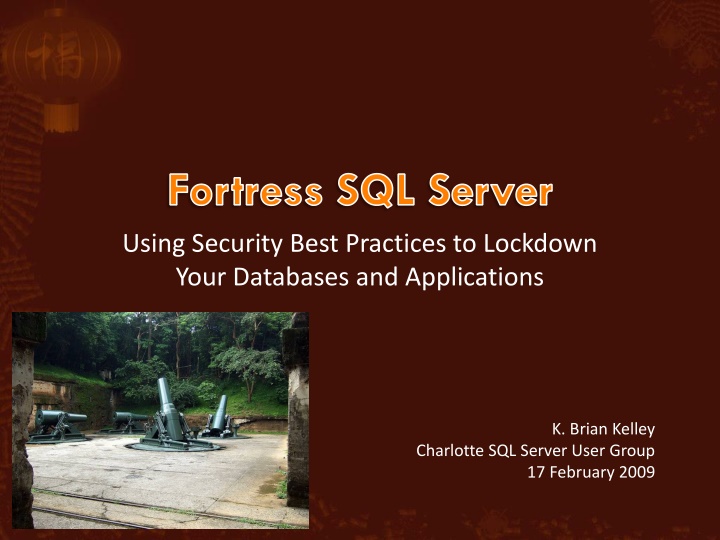
Best Practices for Securing SQL Server Databases and Applications
Learn about security best practices, risk assessment, and the principles of least privilege and defense in depth for locking down your SQL Server environment. Explore qualitative risk assessment examples and how to protect data confidentiality, integrity, and availability.
Download Presentation

Please find below an Image/Link to download the presentation.
The content on the website is provided AS IS for your information and personal use only. It may not be sold, licensed, or shared on other websites without obtaining consent from the author. If you encounter any issues during the download, it is possible that the publisher has removed the file from their server.
You are allowed to download the files provided on this website for personal or commercial use, subject to the condition that they are used lawfully. All files are the property of their respective owners.
The content on the website is provided AS IS for your information and personal use only. It may not be sold, licensed, or shared on other websites without obtaining consent from the author.
E N D
Presentation Transcript
Fortress SQL Server Using Security Best Practices to Lockdown Your Databases and Applications Battery Way K. Brian Kelley Charlotte SQL Server User Group 17 February 2009
My Background Now: Microsoft SQL Server MVP - 2009 Database Administrator / Architect (again, and much happier) Formerly: Infrastructure and security architect Incident response team lead Certified Information Systems Auditor (CISA) SQL Server security columnist / blogger SQLServerCentral.com MSSQLTips.com Co-Author of How to Cheat at Securing SQL Server 2005 (Syngress) Authentication DDL and Login Triggers Co-Author of Professional SQL Server 2008 Administration (Wrox) Securing the Database Engine
Agenda Review of Basic Security Principles Qualitative vs. Quantitative Risk Assessment Threat Vectors Protecting the Server What We Can Do within SQL Server
A Brief Coverage of SECURITY PRINCIPLES
The C-I-A Triad Confidentiality Integrity Availability
Principle of Least Privilege Only what s needed. No less, no more. Too little and the job doesn t got done. Too much, and you ve increased your risk!
Defense in Depth Security is like an onion. It has layers. Not just more, but different, too. Think about the old game Breakout. Image:Breakout2600.png
Two Types of RISK ASSESSMENT
Qualitative Risk Assessment We can describe what can happen. We can make general assumptions to the likelihood, impact, and cost. But we can t give hard numbers We techies can live with this. The business side usually can t.
Qualitative Example An attacker breaches our web application: Gets personal identification data Gets credit card numbers We know we re good, so we say it s not very likely. What exactly does that mean? We know the company is going to take a publicity hit. How much will it cost? Can we measure any of this?
Quantitative Risk Assessment How likely is an incident to occur in a year? How much damage will we suffer? Looking for reasonable estimates. Business likes this a lot. Allows us to justify spending more resources. Harder to do, but obviously worth it.
Quantitative Example An attacker breaches our web application: Gets personal identification data Gets credit card numbers Likelihood Estimate: Once every 3 years Cost: $43.5M Customer Notification: $1.5M Loss of Business: $37M Fix Security Hole: $5M Annual Loss Expectancy = $43.5M / 3 = $14.5M Think we can get that extra 6 weeks for code review / security fixes now?
Finding your inner ninja or thinking about THREAT VECTORS
Threat Vectors Means of attacking the system (or the users) First, brainstorm. Don t throw anything out. Second, consider likelihood. Third, estimate damage. Fourth, determine defenses. Fifth, calculate expense.
Back to Our Example Web Application obvious attacks: SQL injection Cross-site scripting Attack web server directly Attack OS directly Phishing attack on user Get an admin to click on a malicious link and steal information Trojan Horse on user Happened with Valve on Half-Life 2. It can happen to you.
Building a hard shell, or, SECURING THE SERVER ITSELF
Lets Talk Operating System The Basics What is Often Missed When You Really Have to Lock it Up
OS Basics Keep the OS Patched MS08-067 (Oct 2008) Big problem SQL Server is usually not the issue! Know who is in the Administrators group Know who is in the Power Users group From the 10 Immutable Laws of Security: Law #2: If a bad guy can alter the operating system on your computer, it's not your computer anymore Law #6: A computer is only as secure as the administrator is trustworthy
What about MS09-004? Affects SQL Server 2000 SP4 and 2005 SP2 SQL Server 2005 SP3 includes the fix SQL Server 2008 not affected Vulnerability in a replication extended stored procedure Buffer overflow attack Must be logged on to SQL Server to use it. Workarounds are to drop or restrict access (DENY EXECUTE) to: sp_replwritetovarbin
What is Often Missed What other apps are installed? IIS SQL Server Reporting Services Backup Agents Monitoring Agents Network Shares Know who is in Remote Desktop Users Know who can get physical access: Law #3: If a bad guy has unrestricted physical access to your computer, it's not your computer anymore also from the 10 Immutable Laws of Security
What Else? Bitlocker / EFS - Encryption IPSEC Policy Host-Based Intrusion Prevention Automated Audits Group Policy- Enforce Settings
We interrupt this station to look at TECHNICAL SECURITY SOLUTIONS FOR SQL SERVER
For the DBA Server Level Security Database Level Security Auditing Logins
Server Level Security Surface area is critical Surface Area Configuration Tool (2005) Surface Area Configuration facet and Policy Management (2008) Use Windows authentication only (if you can) SA account Strong password even if Windows auth only Registry hack all it takes to change behavior No one should know this password Make it impossible to remember (password generator) Store it away safely in case you do need it Two people generated Rename & Disable if possible (SQL Server 2005/2008)
Server Level Security Control membership for SysAdmin BUILTIN\Administrators What to do? Cluster service account not necessary Local System necessary for Full Text (SQL 2000) Keep track of membership of all fixed server roles ProcessAdmin SecurityAdmin ServerAdmin Use sp_helpsrvrolemember system stored procedure
Server Level Security SQL Server 2005 and above Server securable Permissions granted at a granular level. Not necessarily rolled to a server role Query: SELECT prin.name [Login], perm.permission_name, perm.state_desc FROM sys.server_permissions perm JOIN sys.server_principals prin ON perm.grantee_principal_id = prin.principal_id ORDER BY [Login], permission_name
Server Level Security Track ALL logins to SQL Server Understand extent of mappings for Windows security groups Can nest many, many levels. Track em all down. Users can have multiple security groups. Work with system / directory administrators. Where to look: SQL Server 2000: syslogins SQL Server 2005/8: sys.server_principals, sys.sql_logins
Server Level Security SQL Server 2000 query: SELECT name, CASE isntname WHEN 0 THEN 'N' ELSE 'Y' END [Windows_Account], CASE denylogin WHEN 0 THEN 'N' ELSE 'Y' END [Login_Denied] FROM syslogins
Server Level Security SQL Server 2005/8 query: SELECT name, 'Y' [Windows_Account], 'Y' [Account_Policy], 'Y' [Password_Expiration] FROM sys.server_principals WHERE type IN ('G', 'U') UNION ALL SELECT name, 'N', CASE is_policy_checked WHEN '0' THEN 'N' ELSE 'Y' END, CASE is_policy_checked WHEN '0' THEN 'N' ELSE CASE is_expiration_checked WHEN '0' THEN 'N' ELSE 'Y' END END FROM sys.sql_logins
Database Level Security Transparent Data Encryption in SQL Server 2008 EE Understand difference between dbo and db_owner Sysadmin role members map in as dbo Database roles to keep track of: db_ddladmin db_owner db_SecurityAdmin Use sp_helprolemember to list members Don t allow guest user Exceptions: master, tempdb, msdb
Database Level Security Like logins, track all users Determine their mappings to logins Track all roles remember, they can nest! Determine what users are members of what roles Aggregate of these determines permissions within a database Often important for compliance monitoring
Database Level Security SQL Server 2000 query: SELECT sl.name [Login], su.name [User] FROM master..syslogins sl JOIN sysusers su ON sl.sid = su.sid WHERE hasdbaccess = 1 AND issqlrole = 0
Database Level Security SQL Server 2005/8 query: SELECT sprin.name [Login], dprin.name [User] FROM sys.database_principals dprin LEFT JOIN sys.server_principals sprin ON dprin.sid = sprin.sid WHERE dprin.type NOT IN ('A', 'R')
Database Level Security Watch for Cross Database Ownership Chaining Mandatory for master, msdb and tempdb Do not turn on server wide Owner of database is the login for dbo-owner objects (reason against same login owning every database) Check at both server and database level Server: sp_configure cross db ownership chaining DB: sp_dboption [Database Name], db_chaining
Database Level Security Mapping Permissions SQL Server 2000: sp_helprotect does it all Syspermissions can be used, too SQL Server 2005/8: sp_helprotect isn t the answer. Misses SQL Server 2005 securables (schemas, database) Sys.database_permissions Key on class Schema_name() Object_name()
Using sys.database_permissions SELECT class_desc , CASE WHEN class = 0 THEN DB_NAME() WHEN class = 1 THEN OBJECT_NAME(major_id) WHEN class = 3 THEN SCHEMA_NAME(major_id) END [Securable] , USER_NAME(grantee_principal_id) [User] , permission_name , state_desc FROM sys.database_permissions
Implicit Permissions dbo No blocking even using DENY db_owner Access unless blocked with DENY db_datareader SELECT against all tables & views unless blocked with DENY db_datawriter INSERT, UPDATE, and DELETE against all tables & views unless blocked with DENY
Auditing Logins Not a Setting within SQL Server Stored in the Registry Must use GUI to change values Requires SQL Server restart to take effect Records Events in Application Event Log SQL Server 2000: Information Event ID 17055 Must read details on event entry to see success/failure SQL Server 2005/8: Audit Success Event ID 18453 Audit Failure Event ID 18456 Audit Failures at a Minimum Shiny, new Audit object in SQL Server 2008 EE!
For the Developer Logins vs. Users Protect the Credentials Database Roles Principle of Least Privilege Ownership Chains Securables
Logins vs. Users Logins allow access to SQL Server Called Server Principals in SQL Server 2005/8 SQL Server Logins Windows Logins Windows Users Windows Security Groups Users allow access to a Database Called Database Principals in SQL Server 2005/8 Usually Mapped to a Login Doesn t Have to be in SQL Server 2005/8
Protect the Credentials Use Windows authentication whenever possible Just because Microsoft does it doesn t make it acceptable If SQL Server authentication is required, never store the credentials in plain-text Especially avoid plain-text in logical places: *.config *.ini An attacker can use Search against you, so really no where is safe Encrypt the credentials! ASPNET_IISREG is your friend If you go the do it yourself route, ensure the encryption protocol is sound Compiling it into the application is not secure (Google for hex editor )
Database Roles Like Security Groups in Windows Contains a group of database users User-defined database roles can be nested Best practice says to build logical roles and assign permissions accordingly Same idea as Windows groups for permissions Do not use Public role Stay away from db_datareader and db_datawriter
Database Roles Example: State Park Cabin Reservations Three Levels of Access Web Registration Can submit a reservation (cannot override) Can cancel a reservation Can view all reservation details without sensitive data Assisted Registration Can submit a reservation (cannot override) Can edit a reservation (cannot override) Can cancel a reservation Can view all reservation details, including credit card Park Ranger Can submit a reservation (can override) Can edit a reservation (can override) Can cancel a reservation Can view all reservation details, including credit card
Database Roles Example: State Park Cabin Reservations Three Database Roles Web Registration: Web User Assisted Registration: Reservation Agent Park Ranger: Park Ranger Creating Roles: SQL Server 2000: sp_addrole SQL Server 2005/8: CREATE ROLE Adding members to a role: All 3: sp_addrolemember
Principle of Least Privilege Don t use sa. Ever. There is no reason for this Just because a commercial company (even a security company) does it doesn t make it right. Don t use dbo. There is usually no reason for this. Even if Microsoft does! Don t use db_owner role members. See dbo. Explicitly define permissions against roles. Only grant the rights needed to do the job. Use ownership chaining!
Ownership Chaining Security mechanism specific to SQL Server Recommended best practice Prevents direct access to base tables Reduces number of permissions checks How it works: When one object refers to another, SQL Server may not perform a security check on the object referred to Differs between SQL Server 2000 and 2005/8
Ownership chaining SQL Server 2000: SQL Server checks the owner of the objects If the owner is the same, no security check on the referred to object is no performed. SQL Server 2005/8: Objects are no longer owned (user/schema separation) Objects are part of a schema Schema owners are checked instead If the owner is the same for both schema (or if the objects are in the same schema), no security check on the referred to object is performed.
Ownership chaining Ownership Ownership Chain (Always): Chain (Always): Test.usp_AProc Test.ATable NOT NOT an Ownership Chain in SQL 2000: an Ownership Chain in SQL 2000: X Test.usp_SecondProc Test2.SecondTable
Ownership chaining Ownership Ownership Chain (Always): Chain (Always): Test.usp_AProc Test.ATable Can be Can be an Ownership Chain in SQL an Ownership Chain in SQL 2005/8: 2005/8: Test.usp_SecondProc Test2.SecondTable As long as As long as Test Test and and Test2 Test2 schemas schemas have the same owner! have the same owner!

